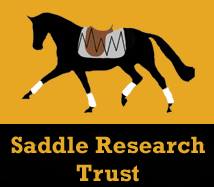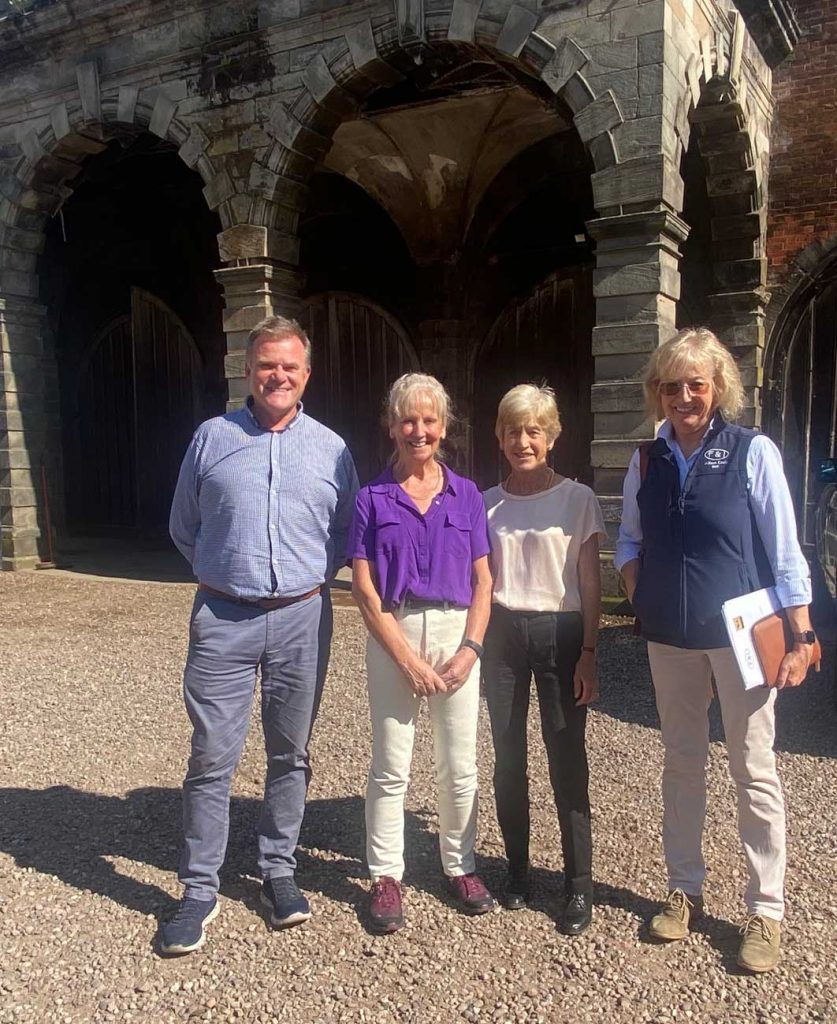Saddle Research Trust Forum
 Protecting Equestrianism’s Social License to Operate in 2022 and Beyond
Protecting Equestrianism’s Social License to Operate in 2022 and Beyond
by Anne Bondi
On 3rd August 2022 a unique forum, organised as a collaborative effort between The Saddle Research Trust (SRT) and the Association of Fellows and Instructors of the British Horse Society (F&I) was held. A group of 46 highly skilled delegates convened at Ingestre Stables, Staffordshire, by kind invitation of co-owners Tim Downes, Fellow of the British Horse Society (FBHS) and Rob Lovatt FBHS. Tasked with considering the pressing issue of equestrian sports’ Social Licence to Operate (SLO) and how we can improve the reputation of the industry amongst the wider public, the jam-packed programme was engaging and provocative from start to finish. Presented by Dr. Anne Bondi and Dr. Sue Dyson, who between them have amassed a wealth of practical and clinical knowledge and experience from Pony Club to PhD level and beyond, they used evidence-based data to develop discussions throughout the day.
Describing equestrian sport as standing on a ‘cliff edge’, Dr. Bondi did not shy away from showcasing some of the damaging scenes and statistics that face the equine industry; from blue tongues to rotational falls and the ludicrousy of ‘marshmallow fluff’, our sport faces a wide array of challenges. The abuse of horses in the modern pentathlon at the Olympic Games, whips in racing and foxhunting with hounds are all highly emotive subjects that demonstrate the ease with which the lay public, who largely have little to no contact with horses, can become engaged with the negative image of our industry, no matter how culturally ingrained and secure we may think it is.
Dr. Dyson introduced the Ridden Horse Pain Ethogram (RHpE) as a performance checklist of 24 behaviours in ridden horses that have been scientifically proven to be more likely to be present in lame than non-lame horses. This valuable tool has been extensively tested to demonstrate that it can be easily and practically applied by individuals who have had basic training in its use. As a guide, horses displaying 8 or more of the behaviours listed in the checklist are highly likely to be experiencing some degree of musculoskeletal pain. Whilst the checklist cannot indicate from where the discomfort originates, it provides a starting point for riders, trainers and other professionals to commence investigations to resolve any underlying problems before they become chronic. In a study to test the efficacy of its practical application, the checklist was used after preliminary training by a group of equine veterinarians to differentiate between non-lame horses and those with low-grade lameness. All the participants found it a very exciting tool to add to their diagnostic armamentarium.
Dr. Dyson has applied the checklist to horses competing from grassroots to elite level, with compelling results. A study of Grand Prix dressage horses gave an average checklist score of only 3/24 and those horses with the lowest checklist scores correlated with higher judges’ marks. This is not only good news for competitors, it also represents a great opportunity to share positive results with the public. Data of 1,010 grass root event horses in competitions ranging from British Eventing (BE) 90 to BE Novice level showed that those horses which scored less than 8/24 finished with better competition results than those with a score of 8/24 or more. Five-star three-day event horses that scored 7 or more were more than twice as likely to fail to complete cross-country than horses with a score of less than 7. This demonstrates that ensuring that your horse is comfortable will lead to better competitive success and is a means to mitigate risks, thus potentially reducing falls and injuries
Application of the checklist will help all equestrian industry stakeholders identify potential pain-related problems early on, providing an opportunity for prompt intervention and improved prognosis. This opportunity for early identification will lead to:
- better, safer riding
- more comfortable, visibly happier horses
- horses that are easier to train
- greater competition successes
- a more palatable reputation across the board
- happy pictures in the media
- social license to operate!
Ingestre Stables generously allowed the use of two of their school horses for the practical element, where Drs. Dyson and Bondi assessed and described the horses’ conformation, posture and gait before observing them being tacked up and under saddle, highlighting the practical application of the performance checklist throughout. Dr. Dyson explained that, although it’s important to recognise each horse’s asymmetries, laterality, and gait pattern as a base line for monitoring, their presence does not necessarily mean that the horse is unfit to work, although it may have a bearing on the type of work it should be used for. Similarly, the recommendation for veterinary intervention may be different for a horse at the start of its career versus an older horse. The checklist does not serve to condemn or prevent the use of horses in sport; it is simply a tool to identify how a ridden horse is coping in its work and allow earlier recognition of potential problems for better welfare and performance outcomes.
The million-dollar question is “What can we do proactively to help protect our SLO?” Consensus was that there will need to be changes across the board, from grassroots to elite level, industry wide. John McEwen, Director of Equine Sports Science and Medicine, World Class Programme and the National Head Veterinarian,British Equestrian Federation, described an example in the sport of Vaulting, where a mark is now awarded for the horse’s movement, which had previously been of no significance to the competition results. By simply adding in this mark, the standard of performance has improved immensely; it now matters how well the horse moves, greater care and attention is paid, and the results are visible. Similarly, in the controversial world of international Endurance, a minimum interval requirement between competitions has been introduced, preventing competitors from competing horses too frequently, which is potentially something that could be adopted in other sports as an equine safeguarding mechanism.
To protect our SLO, we must carefully manage how our sport is publicly viewed and, to this end, delegates felt that using negative imagery and language should be avoided. Instead, we should seek to normalise the image of a happy, healthy athlete. The Ridden Horse Performance Checklist will be further developed to include key indicators which also influence equine performance, such as tack fit and rider position and balance.
The forum consensus was that this message should be conveyed differently to different audiences, further supporting the necessity of adopting a cross-disciplinary approach. Qualified Saddle Fitter and SRT Trustee, Steph Bradley, who is also a dressage rider and coach floated the idea of a module across industry sectors to cover ‘Equine Safeguarding’, whereby organisations would include this content as part of their qualification structure, potentially a great route for automatic dissemination and implementation of knowledge. One delegate described aspects of the knowledge transfer process as ‘cross-pollination’, underlining that there is sometimes a disconnect between clinicians and coaches, whereas we would certainly gain more if there was better communication across the different fields. There was clear agreement that a holistic approach is important, and that veterinarians, physiotherapists, farriers and coaches should work together for better outcomes.
Beyond the evidence-based data available, the wealth of experience amongst the delegates led to much thought-provoking discussion throughout the day, for example, whether better production of the young horse could improve outcomes later in life.
With many coaches present, discussion turned to the influence of the rider on the horse, and whether training regimes and rider skill level may lead to compensatory movement patterns and the development of gait abnormalities and pain-related issues in the first place. Delegates were challenged with the question, “Has the introduction of the word ‘collection’ in dressage tests served to encourage ‘backward’ riding that is not conducive to healthy balance and long-term soundness?” Whilst Dr. Dyson disputed that all issues could be resolved through improved riding, she acknowledged that rider balance and skill are crucial parts of the equation and that long-term rider imbalance may predispose to lameness development, so this is certainly an area that should not be overlooked.
There is a problem throughout the industry, from riding schools upwards, whereby horses are deemed to be ‘normal’ but are not necessarily healthy. We need to challenge this and encourage everyone to revise what is considered ‘normal’; to create a healthier image of leisure and sports horses and allow this to become the new normal. This culture shift doesn’t only start with riding school users, but also with elite athletes. In elite competition some unacceptable practices seem to be socially acceptable and normalised; e.g., if a horse’s bit splits its mouth during competition, there is no shame amongst the riders as this is simply seen as an occupational hazard. This mentality does not have horse welfare at the heart of it.
Delegates agreed that the idea of sharing welfare success stories, where horses’ needs are put above financial gain or success should be encouraged. Take, for instance, one of the demonstration horses, which, despite being a very valuable horse, was given to Ingestre at the peak of its career to safeguard its welfare rather than risk its talents being exploited through greed. Representatives from the F&I also supported the need to highlight and promote the good practices to help maintain public support.
One former elite event rider and now a BE Master Coach, shared that there are consequences for failure to heed warnings when vying for team selection. Riders have been excluded from selection if they have not improved their conduct after previous warnings, for example for excessive use of the whip. Although this can be an unpopular action for selectors to make, it is reassuring that poor conduct has consequences at this level. Event rider, Tina Canton BHSI, raised the issue of consequences for poor riding at grassroots level, where some of the images seen can be particularly uncomfortable. She suggested that a yellow card system could be introduced, but also warned that it may be difficult to enforce. This ties in with the issue of judging and stewarding at all levels throughout the sport: due to the huge numbers of people required to run events, to truly improve standards there would be a considerable cost implication. It was felt that ultimately, the end user must pay for the sport. It was also acknowledged that the stewards and judges are in difficult positions, and adverse comments are not always well received by competitors. Moreover, it was pointed out that owners have the capacity to be very influential because they financially support a lot of the elite horses and riders.
We cannot be seen to be divided or divisive. Communication will be key to ensure that everybody is working to the same goal: saving equestrianism’s SLO, safeguarding not only the future of the sport, but the welfare of our horses. The industry should not choose to retreat behind closed doors, but instead implement changes in everyone’s best interests so that horses can exist in sport with an open-door policy; there shouldn’t be anything to hide!
The final discussion panel, chaired by Dr. Anne Bondi, was made up of former Olympic event rider Andrew Bennie FBHS who is also a BD List 1 Judge and an FEI Eventing International judge, Tim Downes, John McEwen and Dr. Sue Dyson. The panel members were encouraging throughout their feedback on the format of the day. John McEwen advised that the Performance Checklist should be part of a package and used as a tool to monitor performance. Tim Downes highlighted that we should take advantage of the existing organisations and governing bodies to help disseminate knowledge through the various assessment and qualification routes already offered. Andrew Bennie agreed that the message must be made palatable for the general population and that the information could be filtered down to the lower levels through coaches etc. Supporting that, when planning future educational seminars, it may be best to start at the top and work down, adjusting the message for the different audiences. Overall, feedback was very positive, offering reassurance that the industry’s eyes are wide open to the issues at hand and individuals from different sectors are prepared to get involved to help protect equine welfare and the SLO. The valuable feedback gained from the forum will be employed to review and update the content and format, to develop the future, wider series of educational seminars to protect equestrianism’s SLO.

